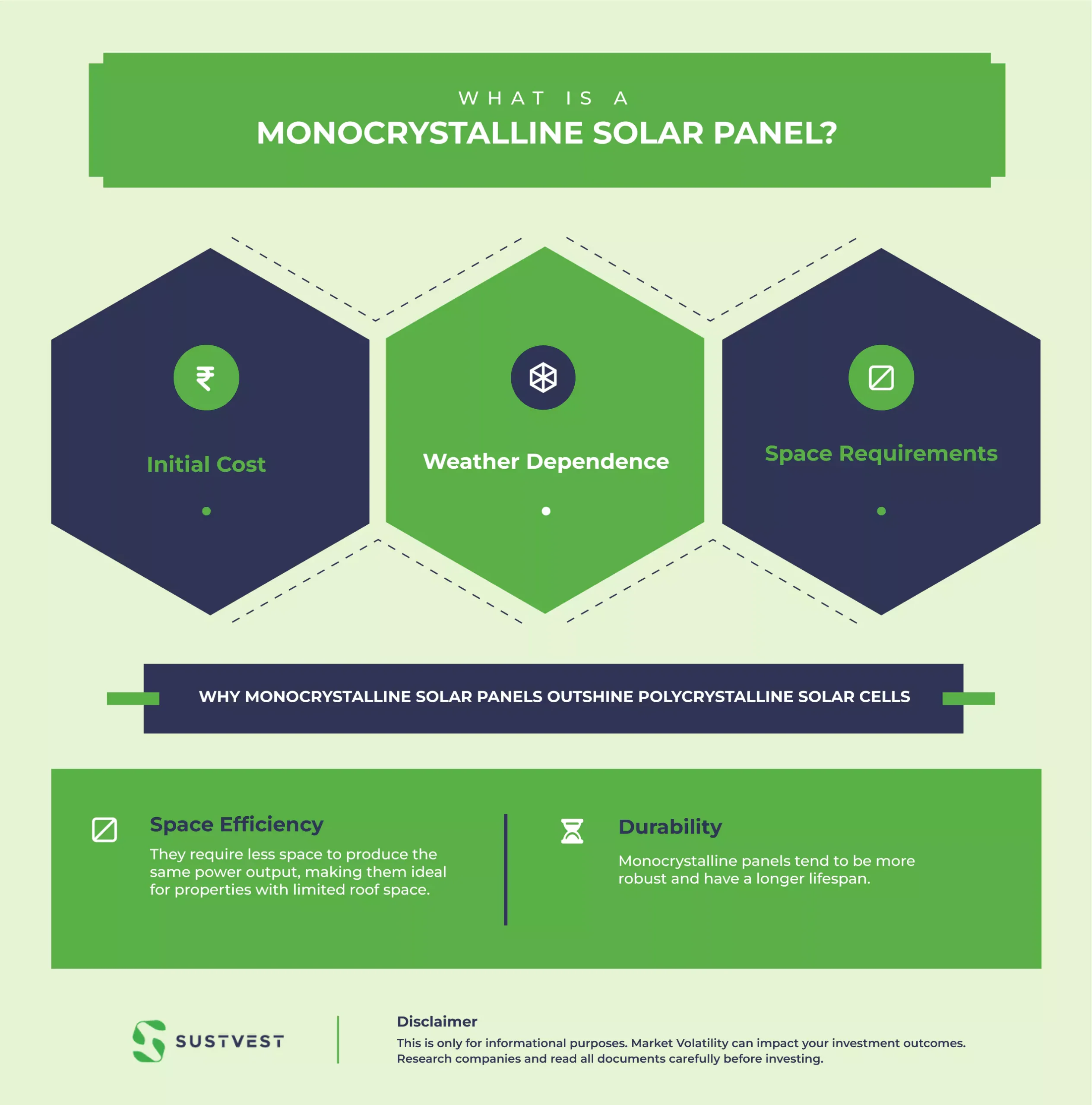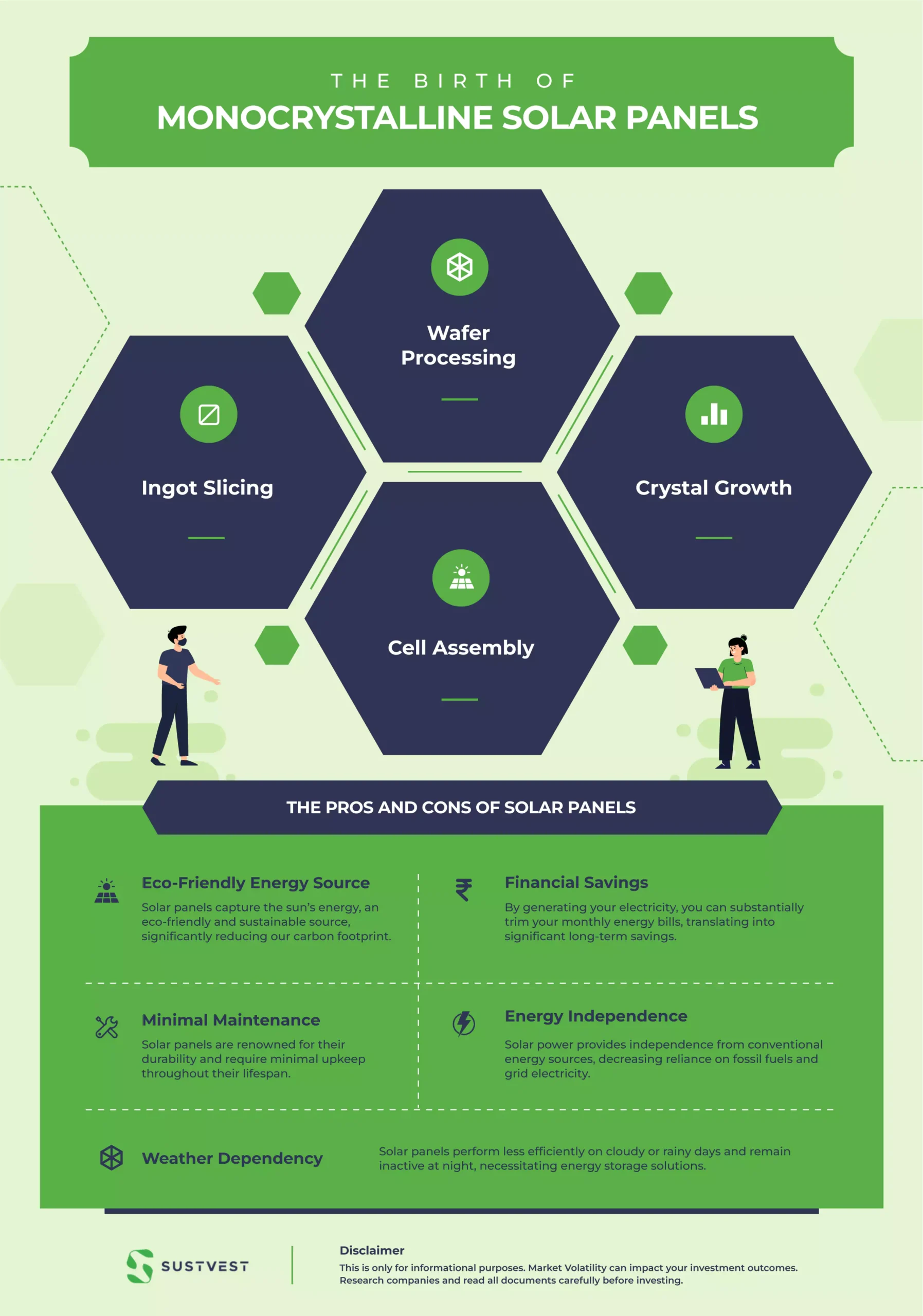Introduction to Solar Power
Solar power is one of the most important environmentally friendly ways to produce electricity. You will learn about what is a Monocrystalline solar panel, its advantages and drawbacks in this article.

What is a Monocrystalline Solar Panel?
You must be wondering what is a Monocrystalline Solar Panel. It is nothing but a type of solar panel. Monocrystalline panels are known for their exceptional efficiency and high quality.Before getting to know about the Monocrystalline panels, you have to know the advantages of using solar panels.
Advantages:
1. Initial Cost: The upfront expense of purchasing and installing solar panels can be a barrier for some homeowners, despite long-term savings.
2. Weather Dependence: Solar panels are less effective during cloudy or rainy days and do not generate power at night, necessitating energy storage solutions.
3. Space Requirements: Installing solar panels requires ample space, which may not be available in all property settings.
You should also know about how solar panels are made to understand the Monocrystalline Solar Panels.

Monocrystalline and Polycrystalline Solar Panels
Choosing between monocrystalline and polycrystalline panels is a pivotal decision in your solar journey. Let’s explore why monocrystalline solar panels are often considered superior.
Demystifying Monocrystalline Solar Panels
Monocrystalline solar panels are easily identifiable by their distinct appearance, characterized by rounded edges. This unique feature results from their manufacturing process, which contributes to their efficiency.
Why Monocrystalline Solar Panels Outshine Polycrystalline Solar Cells
1. Space Efficiency: They require less space to produce the same power output, making them ideal for properties with limited roof space.
2. Durability: Monocrystalline panels tend to be more robust and have a longer lifespan.
The Mystery Behind Rounded Corners
The rounded corners on monocrystalline solar panels are a result of their manufacturing process. Single-crystal silicon ingots are cut into cylindrical shapes, naturally leading to these distinctive edges.
Unveiling the Drawbacks of Monocrystalline Solar Panels
Drawbacks of Monocrystalline Solar Panels
Shading Issues: Even partial shading on a monocrystalline panel can significantly impact its performance, making proper installation critical.
The Birth of Monocrystalline Solar Panels
Understanding the manufacturing process of monocrystalline solar panels sheds light on their quality and efficiency.
The Creation of Monocrystalline Solar Panels
1. Crystal Growth: Monocrystalline solar panels begin as silicon crystal seeds and grow into larger ingots through a process called Czochralski pulling.
2. Ingot Slicing: The grown ingot is sliced into thin wafers using diamond wire saws.
3. Wafer Processing: These wafers undergo treatment, doping, and texturing to enhance their electrical conductivity and light absorption.
4. Cell Assembly: The processed wafers are assembled into cells and interconnected to form a complete solar panel.

Monocrystalline vs. Amorphous Solar Panels
Monocrystalline solar panels are not the sole option available.
Monocrystalline vs. Amorphous Solar Panels
Efficiency: Monocrystalline panels are more efficient and yield higher power outputs compared to amorphous panels.
A Beginner’s Introduction to Solar Power
Solar power is transforming how we produce electricity, making it accessible to homeowners and businesses alike. For newcomers to the realm of solar energy, grasping its fundamental components is crucial. You should know about the Top 10 Solar Panel Manufacturers in India in 2023.
The Pros and Cons of Solar Panels
Advantages of Solar Panels:
1. Eco-Friendly Energy Source: Solar panels capture the sun’s energy, an eco-friendly and sustainable source, significantly reducing our carbon footprint.
2. Financial Savings: By generating your electricity, you can substantially trim your monthly energy bills, translating into significant long-term savings.
3. Minimal Maintenance: Solar panels are renowned for their durability and require minimal upkeep throughout their lifespan.
4. Energy Independence: Solar power provides independence from conventional energy sources, decreasing reliance on fossil fuels and grid electricity.
5. Weather Dependency: Solar panels perform less efficiently on cloudy or rainy days and remain inactive at night, necessitating energy storage solutions.
6. Space Requirement: Installing solar panels demands ample space, which may not be feasible in all property configurations. Monocrystalline panels are identifiable by their rounded edges, a unique trait originating from their production process.
The Efficiency of Monocrystalline Solar Panels
Monocrystalline solar panels gain recognition for their efficiency, typically ranging from 15% to 22%. This efficiency enables them to convert more sunlight into electricity, making them an attractive choice for optimizing power generation within limited spaces.
Unveiling the Production of Monocrystalline Solar Panels
Understanding the manufacturing process behind monocrystalline solar panels sheds light on their quality and efficiency.
The Creation of Monocrystalline Solar Panels
Monocrystalline panels begin their journey as tiny silicon crystal seeds that grow into larger ingots through a process known as Czochralski pulling. These ingots are later sliced into thin wafers, subjected to treatments, doping, and texturing to enhance their electrical conductivity and light absorption. Finally, these processed wafers are assembled into cells, interconnected, and enclosed to form complete solar panels.
Monocrystalline vs. Amorphous Solar Panels
While monocrystalline panels are a popular choice, it’s essential to explore the distinctions between them and amorphous (thin-film) solar panels to make informed decisions.
Monocrystalline vs. Amorphous Solar Panels
1. Efficiency: Monocrystalline panels outperform amorphous panels in terms of efficiency, resulting in higher power outputs.
2. Space Efficiency: Amorphous panels are more space-efficient and offer flexibility in terms of installation.
3. Durability: Monocrystalline panels generally have a longer lifespan and higher durability.
The Lifespan and Cost of Monocrystalline Solar Panels
Understanding the lifespan and cost considerations of monocrystalline solar panels is essential for making informed choices.
1. Space Efficiency: Amorphous panels are more space-efficient and flexible in terms of installation.
2. Durability: Monocrystalline panels tend to have a longer lifespan and higher durability.
3. Cost: Amorphous panels are generally more affordable upfront, but their lower efficiency may affect long-term cost-effectiveness.
Understanding the Cost of Monocrystalline Solar Panels
Unraveling the cost of monocrystalline solar panels is essential for budget planning. Larger panels tend to cost more due to increased materials and manufacturing complexity.
The Science of Monocrystalline Solar Panels
Electricity Generation: The electric current is captured and harnessed as usable electricity for your home or business.
FAQs
1. Are monocrystalline solar panels worth the higher cost compared to other types?
Yes, monocrystalline panels are worth the higher initial investment due to their superior efficiency and longer lifespan, leading to greater long-term energy savings.
2. What are the drawbacks of Monocrystalline Panels?
The drawbacks of monocrystalline panels include higher cost, temperature sensitivity, and shading issues.
3. How are monocrystalline solar panels made?
Monocrystalline panels are manufactured through a process involving crystal growth, ingot slicing, wafer processing, and cell assembly. This efficiency makes them a preferred choice for those seeking maximum power generation from limited space.
4. How much does a Monocrystalline Solar Panel cost?
Commercial and utility-scale Monocrystalline Solar Panel installations generally enjoy lower per-watt costs due to economies of scale. Installation expenses, encompassing labor, mounting hardware, electrical work, permits, and more, can substantially augment the overall cost. These installation costs fluctuate based on location and the intricacy of the setup.
Moreover, government incentives like tax credits and rebates play a pivotal role in diminishing the cost of installing Monocrystalline Solar Panels. The accessibility and extent of these incentives are subject to regional variations and can change over time.
5. How do Monocrystalline Solar Panels work?
Monocrystalline Solar Panels operate by harnessing the power of sunlight, which triggers a photovoltaic effect to create an electrical current. Subsequently, they capture and transform this current into practical electricity.
This innovative procedure enables the production of sustainable and renewable electricity from the sun, rendering Monocrystalline Solar Panels a green and environmentally friendly energy solution.
6. How long does a Monocrystalline Solar Panel last?
Monocrystalline Solar Panels may continue to produce electricity beyond their warranty period, their efficiency may gradually decrease over time. This means that after several decades of use, they may still work but at a slightly reduced capacity.
7. Mention the disadvantages of monocrystalline solar panels
1. Temperature Sensitivity: Monocrystalline panels can experience reduced efficiency as they heat up.
2. Manufacturing Energy: The production of Monocrystalline Solar Panels typically requires more energy and involves a more complex manufacturing process compared to some other panel types. While they have a high energy payback over their lifespan, the initial energy investment in production is higher.
8. Explain Monocrystalline vs Polycrystalline Solar Panel in two points
1. Monocrystalline panels can achieve higher efficiency rates, typically ranging from 15% to 22%. This means they can convert a larger proportion of sunlight into electricity compared to Polycrystalline panels, which generally have lower efficiency levels, typically ranging from 13% to 16%.
The higher efficiency of Monocrystalline panels is particularly advantageous when you have limited space for installation, as they can generate more electricity from the same area.
2. The choice between the two can sometimes be influenced by personal aesthetics, as some homeowners prefer the neat and black appearance of Monocrystalline panels for their solar installations.
9. Describe Monocrystalline Solar Panel efficiency
Advanced Manufacturing: Monocrystalline panels are manufactured using advanced techniques that minimize defects and imperfections in the silicon wafers. This precision contributes to higher efficiency levels.
Conclusion
In this comprehensive guide, we have taken a deep dive into unraveling the mysteries surrounding monocrystalline solar panels. We’ve delved into what is a Monocrystalline solar panel, its benefits, drawbacks, the intricate process of manufacturing, efficiency factors, costs involved, and the underlying science governing its functionality. If you are interested in starting a Solar Panel business, get it touch with Sustvest for a detailed guide on solar energy.

Founder of Sustvest
Hardik completed his B.Tech from BITS Pilani. Keeping the current global scenario, the growth of renewable energy in mind, and people looking for investment opportunities in mind he founded SustVest ( formerly, Solar Grid X ) in 2018. This venture led him to achieve the ‘Emerging Fintech Talent of the Year in MENA region ‘ in October 2019.




